Comparison and Review of Critical Care Studies
VerifiedAdded on 2021/04/16
|14
|4408
|381
AI Summary
This assignment provides a comprehensive review of various critical care studies, including comparisons of norepinephrine-dobutamine to epinephrine for hemodynamics and lactate metabolism in cardiogenic shock. It also examines the incidence of neurogenic shock after spinal cord injury, intermittent pneumatic compression versus graduated compression stockings for deep vein thrombosis prophylaxis, airway management in cervical spine injury, medical emergencies, and more. The studies cover a range of topics, including fluid resuscitation, palliative care in ICUs, shock management, sedation in ventilated patients, and real-life use of vasopressors and inotropes in cardiogenic shock.
Contribute Materials
Your contribution can guide someone’s learning journey. Share your
documents today.
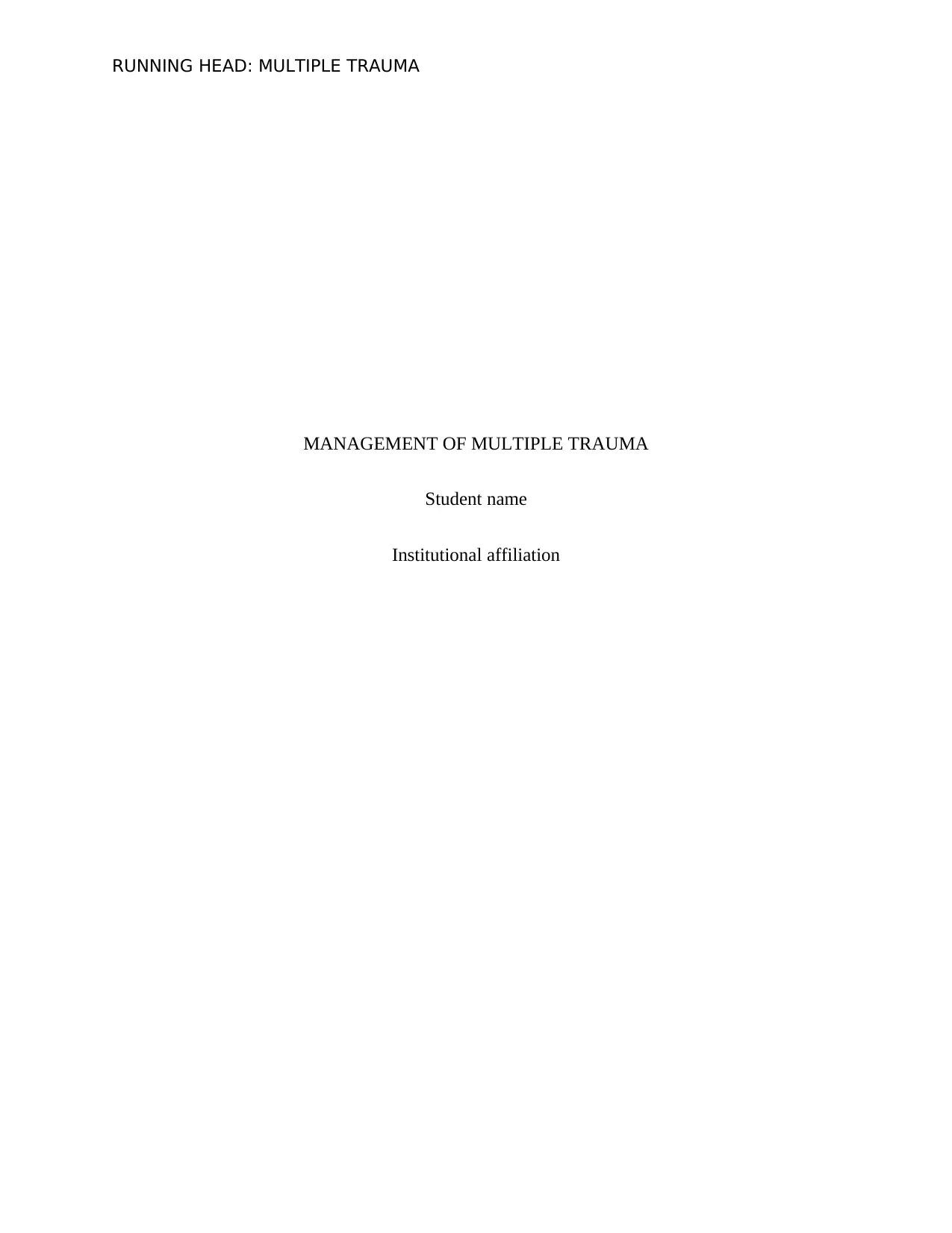
RUNNING HEAD: MULTIPLE TRAUMA
MANAGEMENT OF MULTIPLE TRAUMA
Student name
Institutional affiliation
MANAGEMENT OF MULTIPLE TRAUMA
Student name
Institutional affiliation
Secure Best Marks with AI Grader
Need help grading? Try our AI Grader for instant feedback on your assignments.
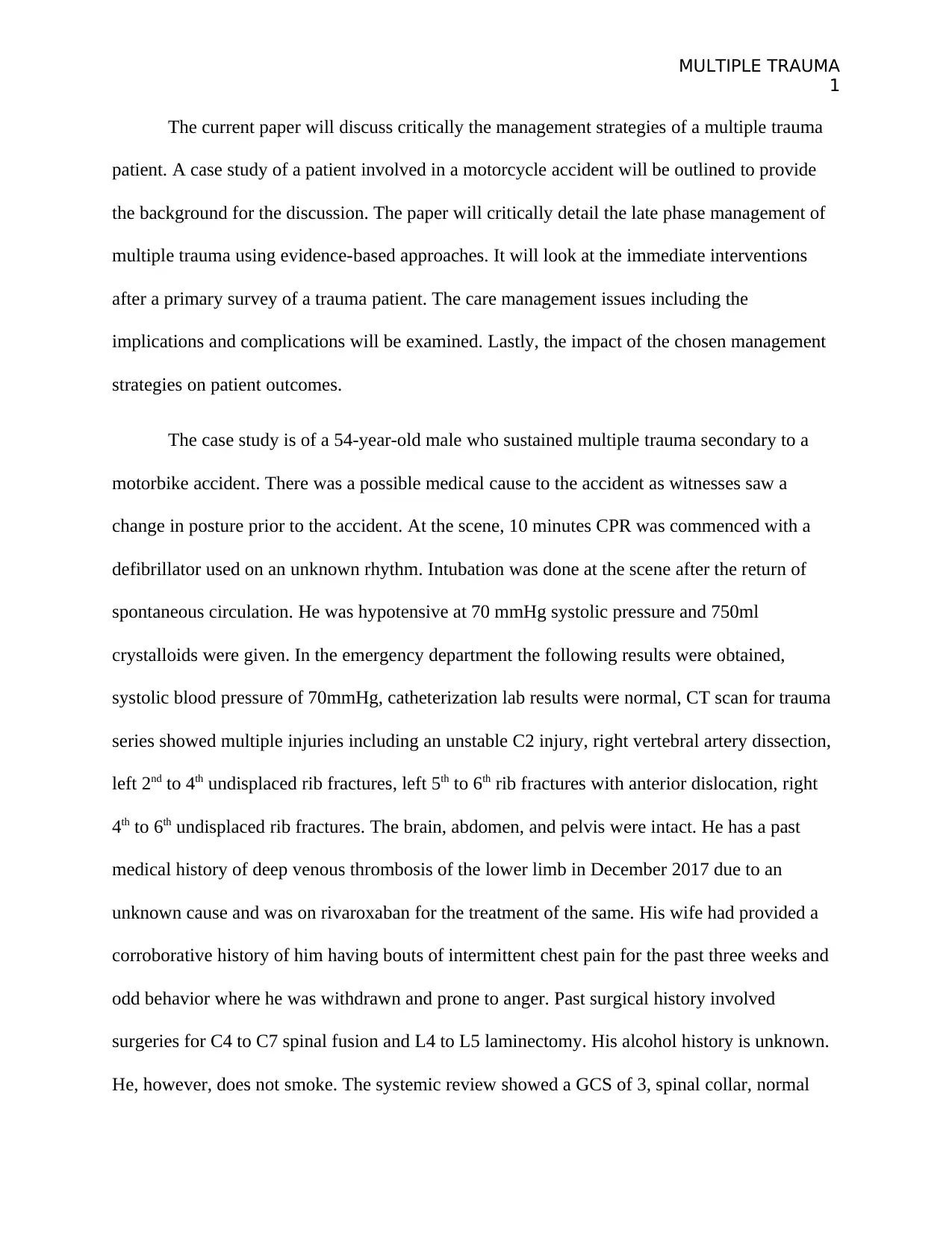
MULTIPLE TRAUMA
1
The current paper will discuss critically the management strategies of a multiple trauma
patient. A case study of a patient involved in a motorcycle accident will be outlined to provide
the background for the discussion. The paper will critically detail the late phase management of
multiple trauma using evidence-based approaches. It will look at the immediate interventions
after a primary survey of a trauma patient. The care management issues including the
implications and complications will be examined. Lastly, the impact of the chosen management
strategies on patient outcomes.
The case study is of a 54-year-old male who sustained multiple trauma secondary to a
motorbike accident. There was a possible medical cause to the accident as witnesses saw a
change in posture prior to the accident. At the scene, 10 minutes CPR was commenced with a
defibrillator used on an unknown rhythm. Intubation was done at the scene after the return of
spontaneous circulation. He was hypotensive at 70 mmHg systolic pressure and 750ml
crystalloids were given. In the emergency department the following results were obtained,
systolic blood pressure of 70mmHg, catheterization lab results were normal, CT scan for trauma
series showed multiple injuries including an unstable C2 injury, right vertebral artery dissection,
left 2nd to 4th undisplaced rib fractures, left 5th to 6th rib fractures with anterior dislocation, right
4th to 6th undisplaced rib fractures. The brain, abdomen, and pelvis were intact. He has a past
medical history of deep venous thrombosis of the lower limb in December 2017 due to an
unknown cause and was on rivaroxaban for the treatment of the same. His wife had provided a
corroborative history of him having bouts of intermittent chest pain for the past three weeks and
odd behavior where he was withdrawn and prone to anger. Past surgical history involved
surgeries for C4 to C7 spinal fusion and L4 to L5 laminectomy. His alcohol history is unknown.
He, however, does not smoke. The systemic review showed a GCS of 3, spinal collar, normal
1
The current paper will discuss critically the management strategies of a multiple trauma
patient. A case study of a patient involved in a motorcycle accident will be outlined to provide
the background for the discussion. The paper will critically detail the late phase management of
multiple trauma using evidence-based approaches. It will look at the immediate interventions
after a primary survey of a trauma patient. The care management issues including the
implications and complications will be examined. Lastly, the impact of the chosen management
strategies on patient outcomes.
The case study is of a 54-year-old male who sustained multiple trauma secondary to a
motorbike accident. There was a possible medical cause to the accident as witnesses saw a
change in posture prior to the accident. At the scene, 10 minutes CPR was commenced with a
defibrillator used on an unknown rhythm. Intubation was done at the scene after the return of
spontaneous circulation. He was hypotensive at 70 mmHg systolic pressure and 750ml
crystalloids were given. In the emergency department the following results were obtained,
systolic blood pressure of 70mmHg, catheterization lab results were normal, CT scan for trauma
series showed multiple injuries including an unstable C2 injury, right vertebral artery dissection,
left 2nd to 4th undisplaced rib fractures, left 5th to 6th rib fractures with anterior dislocation, right
4th to 6th undisplaced rib fractures. The brain, abdomen, and pelvis were intact. He has a past
medical history of deep venous thrombosis of the lower limb in December 2017 due to an
unknown cause and was on rivaroxaban for the treatment of the same. His wife had provided a
corroborative history of him having bouts of intermittent chest pain for the past three weeks and
odd behavior where he was withdrawn and prone to anger. Past surgical history involved
surgeries for C4 to C7 spinal fusion and L4 to L5 laminectomy. His alcohol history is unknown.
He, however, does not smoke. The systemic review showed a GCS of 3, spinal collar, normal
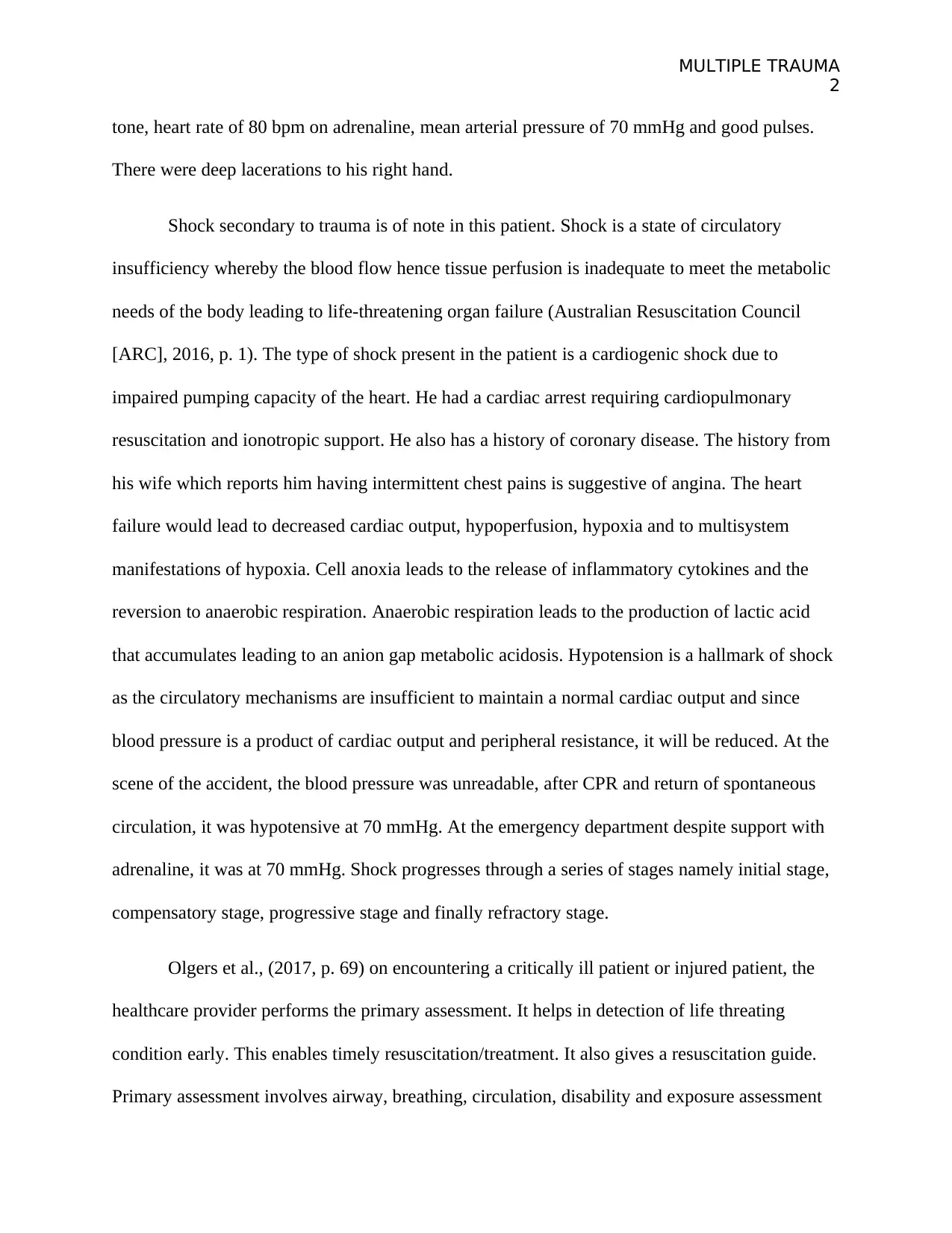
MULTIPLE TRAUMA
2
tone, heart rate of 80 bpm on adrenaline, mean arterial pressure of 70 mmHg and good pulses.
There were deep lacerations to his right hand.
Shock secondary to trauma is of note in this patient. Shock is a state of circulatory
insufficiency whereby the blood flow hence tissue perfusion is inadequate to meet the metabolic
needs of the body leading to life-threatening organ failure (Australian Resuscitation Council
[ARC], 2016, p. 1). The type of shock present in the patient is a cardiogenic shock due to
impaired pumping capacity of the heart. He had a cardiac arrest requiring cardiopulmonary
resuscitation and ionotropic support. He also has a history of coronary disease. The history from
his wife which reports him having intermittent chest pains is suggestive of angina. The heart
failure would lead to decreased cardiac output, hypoperfusion, hypoxia and to multisystem
manifestations of hypoxia. Cell anoxia leads to the release of inflammatory cytokines and the
reversion to anaerobic respiration. Anaerobic respiration leads to the production of lactic acid
that accumulates leading to an anion gap metabolic acidosis. Hypotension is a hallmark of shock
as the circulatory mechanisms are insufficient to maintain a normal cardiac output and since
blood pressure is a product of cardiac output and peripheral resistance, it will be reduced. At the
scene of the accident, the blood pressure was unreadable, after CPR and return of spontaneous
circulation, it was hypotensive at 70 mmHg. At the emergency department despite support with
adrenaline, it was at 70 mmHg. Shock progresses through a series of stages namely initial stage,
compensatory stage, progressive stage and finally refractory stage.
Olgers et al., (2017, p. 69) on encountering a critically ill patient or injured patient, the
healthcare provider performs the primary assessment. It helps in detection of life threating
condition early. This enables timely resuscitation/treatment. It also gives a resuscitation guide.
Primary assessment involves airway, breathing, circulation, disability and exposure assessment
2
tone, heart rate of 80 bpm on adrenaline, mean arterial pressure of 70 mmHg and good pulses.
There were deep lacerations to his right hand.
Shock secondary to trauma is of note in this patient. Shock is a state of circulatory
insufficiency whereby the blood flow hence tissue perfusion is inadequate to meet the metabolic
needs of the body leading to life-threatening organ failure (Australian Resuscitation Council
[ARC], 2016, p. 1). The type of shock present in the patient is a cardiogenic shock due to
impaired pumping capacity of the heart. He had a cardiac arrest requiring cardiopulmonary
resuscitation and ionotropic support. He also has a history of coronary disease. The history from
his wife which reports him having intermittent chest pains is suggestive of angina. The heart
failure would lead to decreased cardiac output, hypoperfusion, hypoxia and to multisystem
manifestations of hypoxia. Cell anoxia leads to the release of inflammatory cytokines and the
reversion to anaerobic respiration. Anaerobic respiration leads to the production of lactic acid
that accumulates leading to an anion gap metabolic acidosis. Hypotension is a hallmark of shock
as the circulatory mechanisms are insufficient to maintain a normal cardiac output and since
blood pressure is a product of cardiac output and peripheral resistance, it will be reduced. At the
scene of the accident, the blood pressure was unreadable, after CPR and return of spontaneous
circulation, it was hypotensive at 70 mmHg. At the emergency department despite support with
adrenaline, it was at 70 mmHg. Shock progresses through a series of stages namely initial stage,
compensatory stage, progressive stage and finally refractory stage.
Olgers et al., (2017, p. 69) on encountering a critically ill patient or injured patient, the
healthcare provider performs the primary assessment. It helps in detection of life threating
condition early. This enables timely resuscitation/treatment. It also gives a resuscitation guide.
Primary assessment involves airway, breathing, circulation, disability and exposure assessment
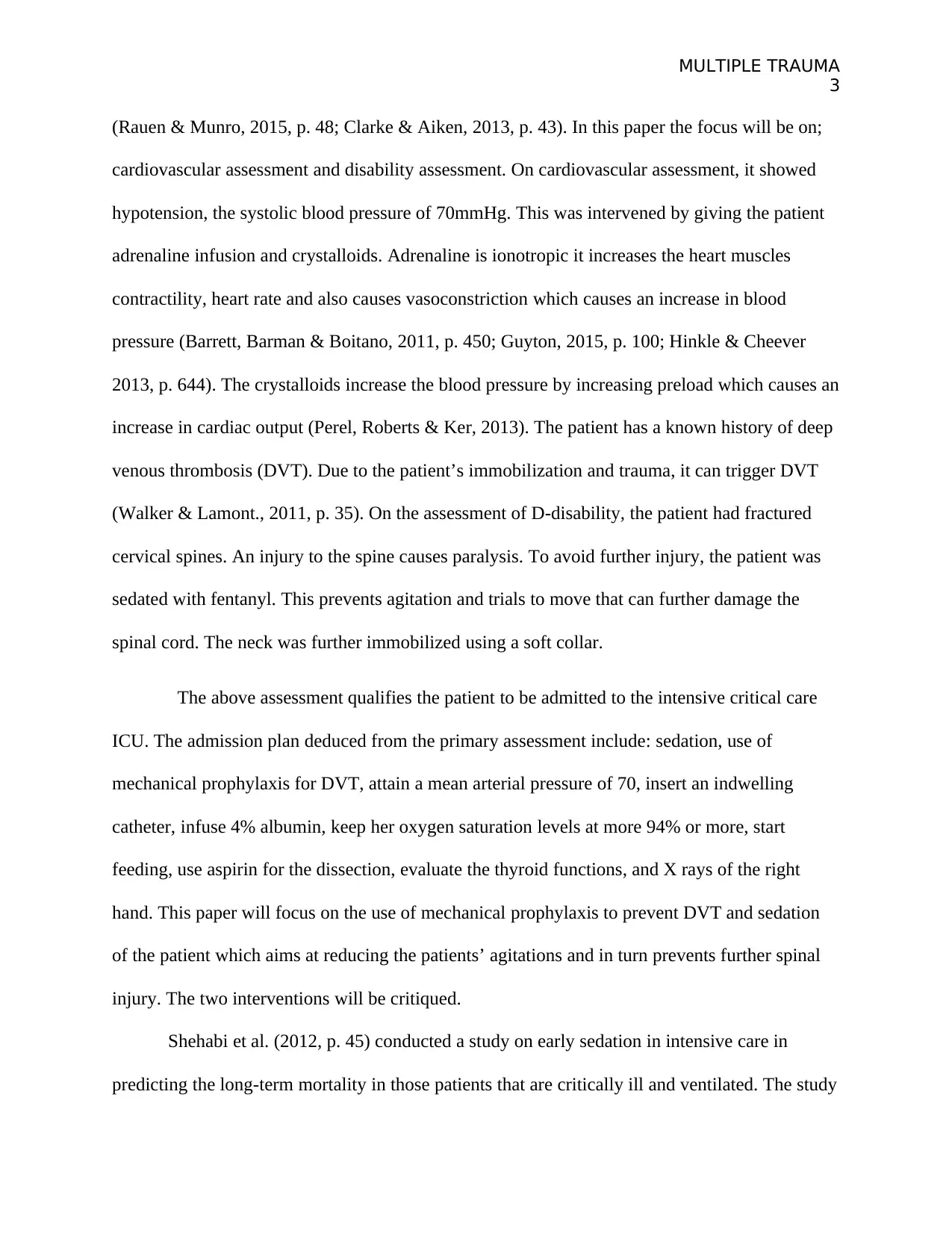
MULTIPLE TRAUMA
3
(Rauen & Munro, 2015, p. 48; Clarke & Aiken, 2013, p. 43). In this paper the focus will be on;
cardiovascular assessment and disability assessment. On cardiovascular assessment, it showed
hypotension, the systolic blood pressure of 70mmHg. This was intervened by giving the patient
adrenaline infusion and crystalloids. Adrenaline is ionotropic it increases the heart muscles
contractility, heart rate and also causes vasoconstriction which causes an increase in blood
pressure (Barrett, Barman & Boitano, 2011, p. 450; Guyton, 2015, p. 100; Hinkle & Cheever
2013, p. 644). The crystalloids increase the blood pressure by increasing preload which causes an
increase in cardiac output (Perel, Roberts & Ker, 2013). The patient has a known history of deep
venous thrombosis (DVT). Due to the patient’s immobilization and trauma, it can trigger DVT
(Walker & Lamont., 2011, p. 35). On the assessment of D-disability, the patient had fractured
cervical spines. An injury to the spine causes paralysis. To avoid further injury, the patient was
sedated with fentanyl. This prevents agitation and trials to move that can further damage the
spinal cord. The neck was further immobilized using a soft collar.
The above assessment qualifies the patient to be admitted to the intensive critical care
ICU. The admission plan deduced from the primary assessment include: sedation, use of
mechanical prophylaxis for DVT, attain a mean arterial pressure of 70, insert an indwelling
catheter, infuse 4% albumin, keep her oxygen saturation levels at more 94% or more, start
feeding, use aspirin for the dissection, evaluate the thyroid functions, and X rays of the right
hand. This paper will focus on the use of mechanical prophylaxis to prevent DVT and sedation
of the patient which aims at reducing the patients’ agitations and in turn prevents further spinal
injury. The two interventions will be critiqued.
Shehabi et al. (2012, p. 45) conducted a study on early sedation in intensive care in
predicting the long-term mortality in those patients that are critically ill and ventilated. The study
3
(Rauen & Munro, 2015, p. 48; Clarke & Aiken, 2013, p. 43). In this paper the focus will be on;
cardiovascular assessment and disability assessment. On cardiovascular assessment, it showed
hypotension, the systolic blood pressure of 70mmHg. This was intervened by giving the patient
adrenaline infusion and crystalloids. Adrenaline is ionotropic it increases the heart muscles
contractility, heart rate and also causes vasoconstriction which causes an increase in blood
pressure (Barrett, Barman & Boitano, 2011, p. 450; Guyton, 2015, p. 100; Hinkle & Cheever
2013, p. 644). The crystalloids increase the blood pressure by increasing preload which causes an
increase in cardiac output (Perel, Roberts & Ker, 2013). The patient has a known history of deep
venous thrombosis (DVT). Due to the patient’s immobilization and trauma, it can trigger DVT
(Walker & Lamont., 2011, p. 35). On the assessment of D-disability, the patient had fractured
cervical spines. An injury to the spine causes paralysis. To avoid further injury, the patient was
sedated with fentanyl. This prevents agitation and trials to move that can further damage the
spinal cord. The neck was further immobilized using a soft collar.
The above assessment qualifies the patient to be admitted to the intensive critical care
ICU. The admission plan deduced from the primary assessment include: sedation, use of
mechanical prophylaxis for DVT, attain a mean arterial pressure of 70, insert an indwelling
catheter, infuse 4% albumin, keep her oxygen saturation levels at more 94% or more, start
feeding, use aspirin for the dissection, evaluate the thyroid functions, and X rays of the right
hand. This paper will focus on the use of mechanical prophylaxis to prevent DVT and sedation
of the patient which aims at reducing the patients’ agitations and in turn prevents further spinal
injury. The two interventions will be critiqued.
Shehabi et al. (2012, p. 45) conducted a study on early sedation in intensive care in
predicting the long-term mortality in those patients that are critically ill and ventilated. The study
Secure Best Marks with AI Grader
Need help grading? Try our AI Grader for instant feedback on your assignments.
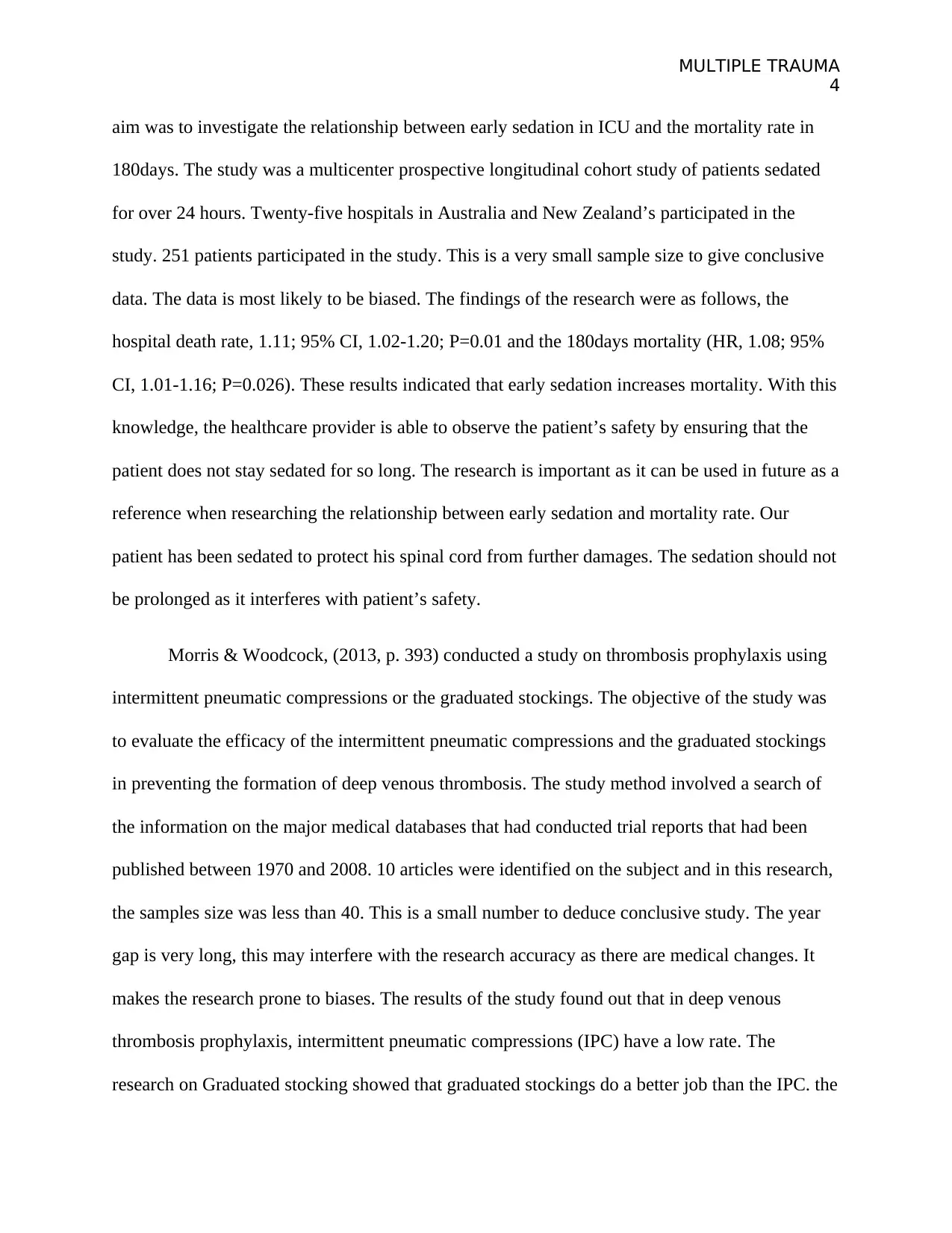
MULTIPLE TRAUMA
4
aim was to investigate the relationship between early sedation in ICU and the mortality rate in
180days. The study was a multicenter prospective longitudinal cohort study of patients sedated
for over 24 hours. Twenty-five hospitals in Australia and New Zealand’s participated in the
study. 251 patients participated in the study. This is a very small sample size to give conclusive
data. The data is most likely to be biased. The findings of the research were as follows, the
hospital death rate, 1.11; 95% CI, 1.02-1.20; P=0.01 and the 180days mortality (HR, 1.08; 95%
CI, 1.01-1.16; P=0.026). These results indicated that early sedation increases mortality. With this
knowledge, the healthcare provider is able to observe the patient’s safety by ensuring that the
patient does not stay sedated for so long. The research is important as it can be used in future as a
reference when researching the relationship between early sedation and mortality rate. Our
patient has been sedated to protect his spinal cord from further damages. The sedation should not
be prolonged as it interferes with patient’s safety.
Morris & Woodcock, (2013, p. 393) conducted a study on thrombosis prophylaxis using
intermittent pneumatic compressions or the graduated stockings. The objective of the study was
to evaluate the efficacy of the intermittent pneumatic compressions and the graduated stockings
in preventing the formation of deep venous thrombosis. The study method involved a search of
the information on the major medical databases that had conducted trial reports that had been
published between 1970 and 2008. 10 articles were identified on the subject and in this research,
the samples size was less than 40. This is a small number to deduce conclusive study. The year
gap is very long, this may interfere with the research accuracy as there are medical changes. It
makes the research prone to biases. The results of the study found out that in deep venous
thrombosis prophylaxis, intermittent pneumatic compressions (IPC) have a low rate. The
research on Graduated stocking showed that graduated stockings do a better job than the IPC. the
4
aim was to investigate the relationship between early sedation in ICU and the mortality rate in
180days. The study was a multicenter prospective longitudinal cohort study of patients sedated
for over 24 hours. Twenty-five hospitals in Australia and New Zealand’s participated in the
study. 251 patients participated in the study. This is a very small sample size to give conclusive
data. The data is most likely to be biased. The findings of the research were as follows, the
hospital death rate, 1.11; 95% CI, 1.02-1.20; P=0.01 and the 180days mortality (HR, 1.08; 95%
CI, 1.01-1.16; P=0.026). These results indicated that early sedation increases mortality. With this
knowledge, the healthcare provider is able to observe the patient’s safety by ensuring that the
patient does not stay sedated for so long. The research is important as it can be used in future as a
reference when researching the relationship between early sedation and mortality rate. Our
patient has been sedated to protect his spinal cord from further damages. The sedation should not
be prolonged as it interferes with patient’s safety.
Morris & Woodcock, (2013, p. 393) conducted a study on thrombosis prophylaxis using
intermittent pneumatic compressions or the graduated stockings. The objective of the study was
to evaluate the efficacy of the intermittent pneumatic compressions and the graduated stockings
in preventing the formation of deep venous thrombosis. The study method involved a search of
the information on the major medical databases that had conducted trial reports that had been
published between 1970 and 2008. 10 articles were identified on the subject and in this research,
the samples size was less than 40. This is a small number to deduce conclusive study. The year
gap is very long, this may interfere with the research accuracy as there are medical changes. It
makes the research prone to biases. The results of the study found out that in deep venous
thrombosis prophylaxis, intermittent pneumatic compressions (IPC) have a low rate. The
research on Graduated stocking showed that graduated stockings do a better job than the IPC. the
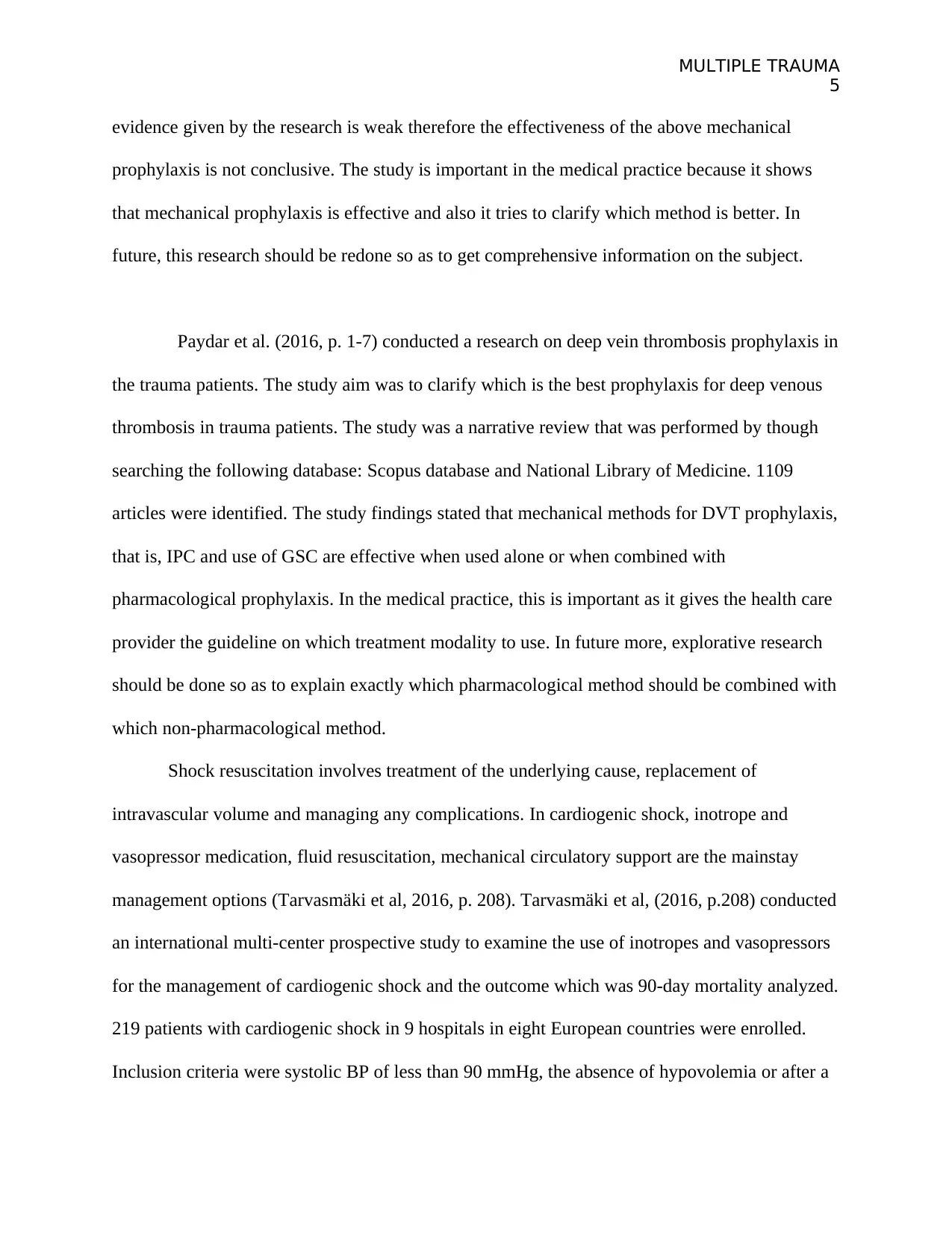
MULTIPLE TRAUMA
5
evidence given by the research is weak therefore the effectiveness of the above mechanical
prophylaxis is not conclusive. The study is important in the medical practice because it shows
that mechanical prophylaxis is effective and also it tries to clarify which method is better. In
future, this research should be redone so as to get comprehensive information on the subject.
Paydar et al. (2016, p. 1-7) conducted a research on deep vein thrombosis prophylaxis in
the trauma patients. The study aim was to clarify which is the best prophylaxis for deep venous
thrombosis in trauma patients. The study was a narrative review that was performed by though
searching the following database: Scopus database and National Library of Medicine. 1109
articles were identified. The study findings stated that mechanical methods for DVT prophylaxis,
that is, IPC and use of GSC are effective when used alone or when combined with
pharmacological prophylaxis. In the medical practice, this is important as it gives the health care
provider the guideline on which treatment modality to use. In future more, explorative research
should be done so as to explain exactly which pharmacological method should be combined with
which non-pharmacological method.
Shock resuscitation involves treatment of the underlying cause, replacement of
intravascular volume and managing any complications. In cardiogenic shock, inotrope and
vasopressor medication, fluid resuscitation, mechanical circulatory support are the mainstay
management options (Tarvasmäki et al, 2016, p. 208). Tarvasmäki et al, (2016, p.208) conducted
an international multi-center prospective study to examine the use of inotropes and vasopressors
for the management of cardiogenic shock and the outcome which was 90-day mortality analyzed.
219 patients with cardiogenic shock in 9 hospitals in eight European countries were enrolled.
Inclusion criteria were systolic BP of less than 90 mmHg, the absence of hypovolemia or after a
5
evidence given by the research is weak therefore the effectiveness of the above mechanical
prophylaxis is not conclusive. The study is important in the medical practice because it shows
that mechanical prophylaxis is effective and also it tries to clarify which method is better. In
future, this research should be redone so as to get comprehensive information on the subject.
Paydar et al. (2016, p. 1-7) conducted a research on deep vein thrombosis prophylaxis in
the trauma patients. The study aim was to clarify which is the best prophylaxis for deep venous
thrombosis in trauma patients. The study was a narrative review that was performed by though
searching the following database: Scopus database and National Library of Medicine. 1109
articles were identified. The study findings stated that mechanical methods for DVT prophylaxis,
that is, IPC and use of GSC are effective when used alone or when combined with
pharmacological prophylaxis. In the medical practice, this is important as it gives the health care
provider the guideline on which treatment modality to use. In future more, explorative research
should be done so as to explain exactly which pharmacological method should be combined with
which non-pharmacological method.
Shock resuscitation involves treatment of the underlying cause, replacement of
intravascular volume and managing any complications. In cardiogenic shock, inotrope and
vasopressor medication, fluid resuscitation, mechanical circulatory support are the mainstay
management options (Tarvasmäki et al, 2016, p. 208). Tarvasmäki et al, (2016, p.208) conducted
an international multi-center prospective study to examine the use of inotropes and vasopressors
for the management of cardiogenic shock and the outcome which was 90-day mortality analyzed.
219 patients with cardiogenic shock in 9 hospitals in eight European countries were enrolled.
Inclusion criteria were systolic BP of less than 90 mmHg, the absence of hypovolemia or after a

MULTIPLE TRAUMA
6
fluid challenge, need for vasopressor therapy to maintain pressure and signs of hypoperfusion in
any organ. Noradrenaline, adrenaline, dopamine, vasopressin, and terlipressin were put as
vasopressors while dobutamine, levosimendan, milrinone, and enoximone as inotropes. Single
and combination use was also analyzed. Results showed that 98% of the patients were treated
with either, and initiated within 24 hours. 90-day mortality was 41%. 75% of patients were given
noradrenaline, 21% adrenaline and 30% given combinations. Only adrenaline was independently
associated with increased 90-day mortality, worsening of renal markers and cardiac markers. No
difference when combinations like noradrenaline and dobutamine were used.
Levy et al (2015, p. 17) is another study that gives recommendations for the management
of cardiogenic shock. It was a forum of top experts in the field of intensive care medicine where
they came up with recommendations for cardiogenic shock. This is to guide management
because unlike septic shock, cardiogenic shock lacks international guidelines for management. it
offered the following recommendations. 1) A coronary cause should be suspected due to the
evidence showing 70 % of causes of cardiogenic shock are due to coronary syndromes (Levy et
al, 2015, p.17). 2) Monitoring in the intensive care unit using an arterial catheter. 3) Organ
function should be checked using markers like kidney function test, liver function tests. 4) A
MAP of above 65 mmHg should be targeted with use of inotropes or vasopressors. 5)
noradrenaline should be used as the vasopressor of choice to reverse hypoperfusion (Levy et al,
2011, p. 452). 6) dobutamine use for the treatment of low cardiac output. 7). Levosimendan or a
phosphodiesterase inhibitor should not be used as first-line drugs. Although these opinions are
from experts in critical care and are supported by a few studies, further studies need to be done to
access all the recommendations with outcomes in mind. Both studies, however, support the use
of vasopressors for circulatory support with noradrenaline as the drug of choice.
6
fluid challenge, need for vasopressor therapy to maintain pressure and signs of hypoperfusion in
any organ. Noradrenaline, adrenaline, dopamine, vasopressin, and terlipressin were put as
vasopressors while dobutamine, levosimendan, milrinone, and enoximone as inotropes. Single
and combination use was also analyzed. Results showed that 98% of the patients were treated
with either, and initiated within 24 hours. 90-day mortality was 41%. 75% of patients were given
noradrenaline, 21% adrenaline and 30% given combinations. Only adrenaline was independently
associated with increased 90-day mortality, worsening of renal markers and cardiac markers. No
difference when combinations like noradrenaline and dobutamine were used.
Levy et al (2015, p. 17) is another study that gives recommendations for the management
of cardiogenic shock. It was a forum of top experts in the field of intensive care medicine where
they came up with recommendations for cardiogenic shock. This is to guide management
because unlike septic shock, cardiogenic shock lacks international guidelines for management. it
offered the following recommendations. 1) A coronary cause should be suspected due to the
evidence showing 70 % of causes of cardiogenic shock are due to coronary syndromes (Levy et
al, 2015, p.17). 2) Monitoring in the intensive care unit using an arterial catheter. 3) Organ
function should be checked using markers like kidney function test, liver function tests. 4) A
MAP of above 65 mmHg should be targeted with use of inotropes or vasopressors. 5)
noradrenaline should be used as the vasopressor of choice to reverse hypoperfusion (Levy et al,
2011, p. 452). 6) dobutamine use for the treatment of low cardiac output. 7). Levosimendan or a
phosphodiesterase inhibitor should not be used as first-line drugs. Although these opinions are
from experts in critical care and are supported by a few studies, further studies need to be done to
access all the recommendations with outcomes in mind. Both studies, however, support the use
of vasopressors for circulatory support with noradrenaline as the drug of choice.
Paraphrase This Document
Need a fresh take? Get an instant paraphrase of this document with our AI Paraphraser

MULTIPLE TRAUMA
7
Pain management is crucial in multiple trauma patients. several pain measurement tools
are available. Behavioral pain scale and the critical care pain observation tool can be applied to
those who can verbalize their pain while the numerical pain scale can be applied to those who
can (Barr et al, 2013, p. 266). According to Puntillo et al, (2014, p. 235), opioids are the first line
analgesics for use in the critical care setting for all types of pain except neuropathic pain. This
was a report from the IPAL-ICU Advisory board that released these guidelines after a thorough
review of existing literature on intensive care, palliative care and the management of pain. A
similar approach was taken by the American college of critical care medicine that brought
together a team of 20 people in the field to come up with guidelines on pain, agitation and
sedation in the critically ill (Barr et al, 2013, p. 263). In this study, the team was divided into four
subcommittees that collaborated for six years to come up with these guidelines. The findings and
results include reports on the incidence of pain, pain assessment, management and the
management of sedation and delirium. They too found opioids titrated to effect are the effective
first-line therapy for pain in the ICU.
Coagulation issues in multiple trauma are valid concerns due to trauma-induced
coagulopathy. Coagulopathy is basically inability of the blood to coagulate properly (Katrancha
& Gonzalez, 2014, p. 55). In trauma the cause is usually multifactorial, the chief being the
depletion, inactivation, and dilution of clotting factors. Several comorbid issues complicate a
coagulopathy including metabolic derangements, hypothermia and fluid therapy (Katrancha &
Gonzalez, 2014, p. 56). The evidence-based approach to management of a coagulopathy in the
critical care setting should be aimed at management of risk factors, hypothermia, fluid
resuscitation that is ample to avoid over dilution, and if necessary medication for anticoagulation
(Katrancha & Gonzalez, 2014, p.56). In the case study, the patient has a prior history of deep
7
Pain management is crucial in multiple trauma patients. several pain measurement tools
are available. Behavioral pain scale and the critical care pain observation tool can be applied to
those who can verbalize their pain while the numerical pain scale can be applied to those who
can (Barr et al, 2013, p. 266). According to Puntillo et al, (2014, p. 235), opioids are the first line
analgesics for use in the critical care setting for all types of pain except neuropathic pain. This
was a report from the IPAL-ICU Advisory board that released these guidelines after a thorough
review of existing literature on intensive care, palliative care and the management of pain. A
similar approach was taken by the American college of critical care medicine that brought
together a team of 20 people in the field to come up with guidelines on pain, agitation and
sedation in the critically ill (Barr et al, 2013, p. 263). In this study, the team was divided into four
subcommittees that collaborated for six years to come up with these guidelines. The findings and
results include reports on the incidence of pain, pain assessment, management and the
management of sedation and delirium. They too found opioids titrated to effect are the effective
first-line therapy for pain in the ICU.
Coagulation issues in multiple trauma are valid concerns due to trauma-induced
coagulopathy. Coagulopathy is basically inability of the blood to coagulate properly (Katrancha
& Gonzalez, 2014, p. 55). In trauma the cause is usually multifactorial, the chief being the
depletion, inactivation, and dilution of clotting factors. Several comorbid issues complicate a
coagulopathy including metabolic derangements, hypothermia and fluid therapy (Katrancha &
Gonzalez, 2014, p. 56). The evidence-based approach to management of a coagulopathy in the
critical care setting should be aimed at management of risk factors, hypothermia, fluid
resuscitation that is ample to avoid over dilution, and if necessary medication for anticoagulation
(Katrancha & Gonzalez, 2014, p.56). In the case study, the patient has a prior history of deep

MULTIPLE TRAUMA
8
venous thrombosis (DVT) hence is at an increased risk of the same or even a fatal pulmonary
embolus. He was managed solely by mechanical DVT prophylaxis with devices like
compression stockings. This is in an attempt to avoid the use of medications that have the
implication of bleeding from trauma points.
Organ-specific management in multiple trauma involves the thorough assessment and
interventions for any organ damage. In the case study, the patient has an unstable fracture of the
c spine, vertebral artery dissection, and multiple rib fractures.
Spine and spinal cord injury management should employ a systematic approach. Injury to the
spinal cord will have varied manifestations. Hemodynamic instability is one due to loss of
sympathetic tone leading to unopposed vasodilatation and systemic hypotension (neurogenic
shock). Mallek et al. (2012, p. 623) described the incidence of neurogenic shock after spinal cord
injury in a retrospective review of medical records from two trauma centers. 180 patients with
different levels of spinal injury were reviewed. The results showed that 8% developed
neurogenic shock. The study limitation is that patient reviews are unreliable in giving a complete
picture. The study used systolic blood pressure as indicators of neurogenic shock which is
unreliable. Spinal fractures will also affect respiration especially cervical spine injuries that
affect the intercostals and lesions above c3 that affect the diaphragm (Hagen, 2015, p. 18). The
guiding principle thus is any cervical spine injury requires intubation. Tracheostomy may be
required to circumvent the complications of prolonged intubation. Motor and sensory deficits
below the level of the injury occur. Spinal cord protection while awaiting definitive management
is key in the emergency setting to prevent injury or repeat injury. A cervical collar for protection
of the cervical spine was employed for the patient in the case study. An estimated 3% to 25% of
spinal injuries occur after the primary trauma (Theodore et al, 2013, p.30). Surgical intervention
8
venous thrombosis (DVT) hence is at an increased risk of the same or even a fatal pulmonary
embolus. He was managed solely by mechanical DVT prophylaxis with devices like
compression stockings. This is in an attempt to avoid the use of medications that have the
implication of bleeding from trauma points.
Organ-specific management in multiple trauma involves the thorough assessment and
interventions for any organ damage. In the case study, the patient has an unstable fracture of the
c spine, vertebral artery dissection, and multiple rib fractures.
Spine and spinal cord injury management should employ a systematic approach. Injury to the
spinal cord will have varied manifestations. Hemodynamic instability is one due to loss of
sympathetic tone leading to unopposed vasodilatation and systemic hypotension (neurogenic
shock). Mallek et al. (2012, p. 623) described the incidence of neurogenic shock after spinal cord
injury in a retrospective review of medical records from two trauma centers. 180 patients with
different levels of spinal injury were reviewed. The results showed that 8% developed
neurogenic shock. The study limitation is that patient reviews are unreliable in giving a complete
picture. The study used systolic blood pressure as indicators of neurogenic shock which is
unreliable. Spinal fractures will also affect respiration especially cervical spine injuries that
affect the intercostals and lesions above c3 that affect the diaphragm (Hagen, 2015, p. 18). The
guiding principle thus is any cervical spine injury requires intubation. Tracheostomy may be
required to circumvent the complications of prolonged intubation. Motor and sensory deficits
below the level of the injury occur. Spinal cord protection while awaiting definitive management
is key in the emergency setting to prevent injury or repeat injury. A cervical collar for protection
of the cervical spine was employed for the patient in the case study. An estimated 3% to 25% of
spinal injuries occur after the primary trauma (Theodore et al, 2013, p.30). Surgical intervention
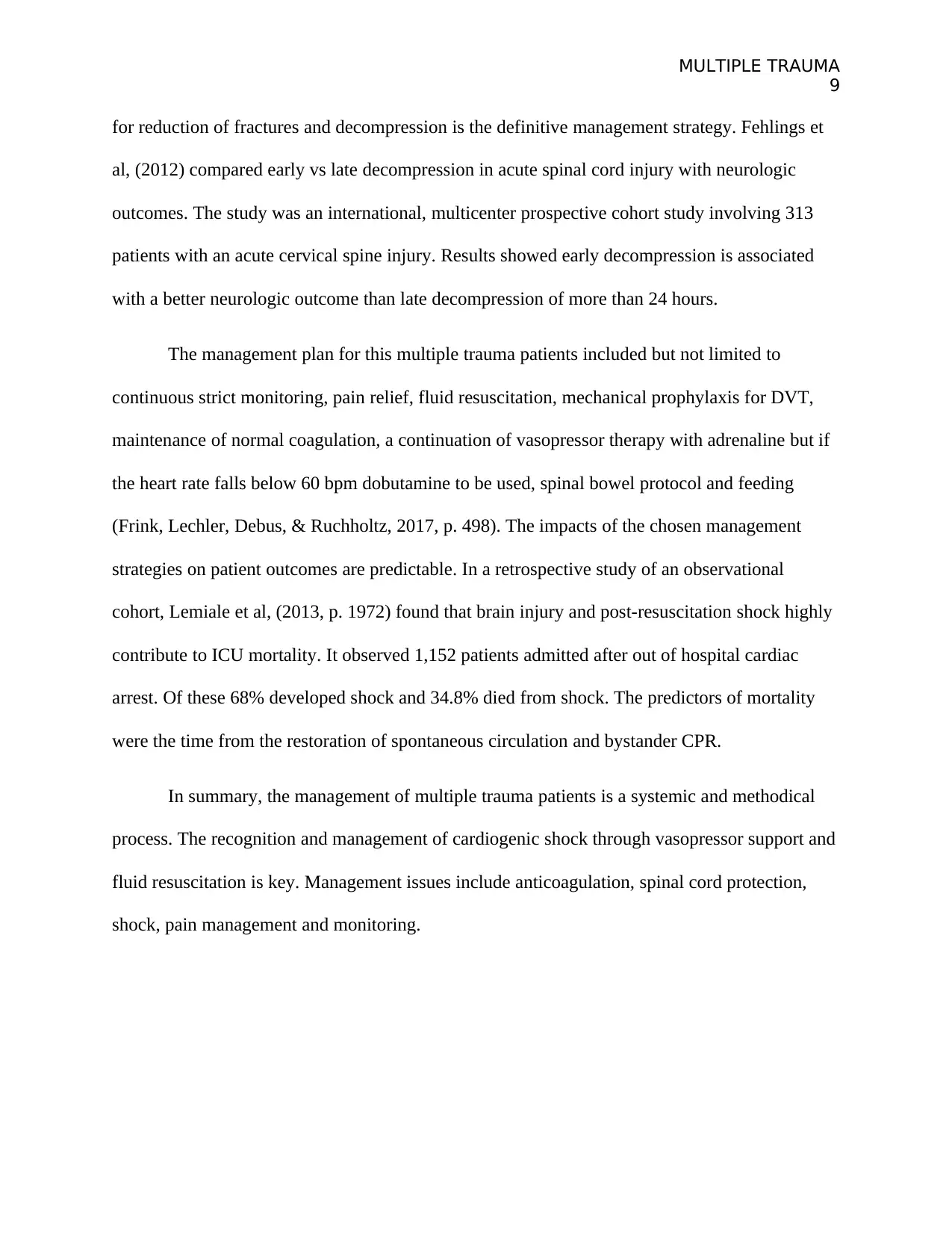
MULTIPLE TRAUMA
9
for reduction of fractures and decompression is the definitive management strategy. Fehlings et
al, (2012) compared early vs late decompression in acute spinal cord injury with neurologic
outcomes. The study was an international, multicenter prospective cohort study involving 313
patients with an acute cervical spine injury. Results showed early decompression is associated
with a better neurologic outcome than late decompression of more than 24 hours.
The management plan for this multiple trauma patients included but not limited to
continuous strict monitoring, pain relief, fluid resuscitation, mechanical prophylaxis for DVT,
maintenance of normal coagulation, a continuation of vasopressor therapy with adrenaline but if
the heart rate falls below 60 bpm dobutamine to be used, spinal bowel protocol and feeding
(Frink, Lechler, Debus, & Ruchholtz, 2017, p. 498). The impacts of the chosen management
strategies on patient outcomes are predictable. In a retrospective study of an observational
cohort, Lemiale et al, (2013, p. 1972) found that brain injury and post-resuscitation shock highly
contribute to ICU mortality. It observed 1,152 patients admitted after out of hospital cardiac
arrest. Of these 68% developed shock and 34.8% died from shock. The predictors of mortality
were the time from the restoration of spontaneous circulation and bystander CPR.
In summary, the management of multiple trauma patients is a systemic and methodical
process. The recognition and management of cardiogenic shock through vasopressor support and
fluid resuscitation is key. Management issues include anticoagulation, spinal cord protection,
shock, pain management and monitoring.
9
for reduction of fractures and decompression is the definitive management strategy. Fehlings et
al, (2012) compared early vs late decompression in acute spinal cord injury with neurologic
outcomes. The study was an international, multicenter prospective cohort study involving 313
patients with an acute cervical spine injury. Results showed early decompression is associated
with a better neurologic outcome than late decompression of more than 24 hours.
The management plan for this multiple trauma patients included but not limited to
continuous strict monitoring, pain relief, fluid resuscitation, mechanical prophylaxis for DVT,
maintenance of normal coagulation, a continuation of vasopressor therapy with adrenaline but if
the heart rate falls below 60 bpm dobutamine to be used, spinal bowel protocol and feeding
(Frink, Lechler, Debus, & Ruchholtz, 2017, p. 498). The impacts of the chosen management
strategies on patient outcomes are predictable. In a retrospective study of an observational
cohort, Lemiale et al, (2013, p. 1972) found that brain injury and post-resuscitation shock highly
contribute to ICU mortality. It observed 1,152 patients admitted after out of hospital cardiac
arrest. Of these 68% developed shock and 34.8% died from shock. The predictors of mortality
were the time from the restoration of spontaneous circulation and bystander CPR.
In summary, the management of multiple trauma patients is a systemic and methodical
process. The recognition and management of cardiogenic shock through vasopressor support and
fluid resuscitation is key. Management issues include anticoagulation, spinal cord protection,
shock, pain management and monitoring.
Secure Best Marks with AI Grader
Need help grading? Try our AI Grader for instant feedback on your assignments.

MULTIPLE TRAUMA
10
References.
Australian Resuscitation Council. (2014). Shock. [online]. Retrieved from
https://resus.org.au/wpfb-file/anzcor-guideline-9-2-3-shock-jan16-pdf/
Barr, J., Fraser, G., Puntillo, K., Ely, E., Gélinas, C., Dasta, J., … Jaeschke, R. (2013). Clinical
practice guidelines for the management of pain, agitation, and delirium in adult patients
in the intensive care unit. Critical Care Medicine, 41(1), 263–306. Retrieved from doi:
10.1097/CCM.0b013e3182783b72
Barrett, E., Barman, M., Boitano, S. (2009). Ganong’s Review of Medical Physiology. (24th ed).
New York, N.Y: McGraw Hill Medical
Clarke, S., Aiken, L. (2013). Failure to rescue. American Journal of Nursing. 103 (1), 42–47
Fehlings, G., Vaccaro, A., Wilson, J., Singh, A., Cadotte, D., Harrop, J., ... Rampersaud, R.
(2012). Early versus delayed decompression for traumatic cervical spinal cord injury:
results of the surgical timing in acute spinal cord injury study (STASCIS). Special Issues
on Trauma. [online]. Retrieved from https://doi.org/10.1371/journal.pone.0032037
Frink, M., Lechler, P., Debus, F., & Ruchholtz, S. (2017). Multiple trauma and emergency room
management. Deutsches Arzteblatt, 114(29-30), 497–503.
Guyton, A. C. (2015). Textbook of Medical Physiology. (13th ed.). Philadelphia: W. B. Saunders
Hagen, M. (2015). Acute complications of spinal cord injuries. World Journal of Orthopedics, 6
(1), 17-23.
10
References.
Australian Resuscitation Council. (2014). Shock. [online]. Retrieved from
https://resus.org.au/wpfb-file/anzcor-guideline-9-2-3-shock-jan16-pdf/
Barr, J., Fraser, G., Puntillo, K., Ely, E., Gélinas, C., Dasta, J., … Jaeschke, R. (2013). Clinical
practice guidelines for the management of pain, agitation, and delirium in adult patients
in the intensive care unit. Critical Care Medicine, 41(1), 263–306. Retrieved from doi:
10.1097/CCM.0b013e3182783b72
Barrett, E., Barman, M., Boitano, S. (2009). Ganong’s Review of Medical Physiology. (24th ed).
New York, N.Y: McGraw Hill Medical
Clarke, S., Aiken, L. (2013). Failure to rescue. American Journal of Nursing. 103 (1), 42–47
Fehlings, G., Vaccaro, A., Wilson, J., Singh, A., Cadotte, D., Harrop, J., ... Rampersaud, R.
(2012). Early versus delayed decompression for traumatic cervical spinal cord injury:
results of the surgical timing in acute spinal cord injury study (STASCIS). Special Issues
on Trauma. [online]. Retrieved from https://doi.org/10.1371/journal.pone.0032037
Frink, M., Lechler, P., Debus, F., & Ruchholtz, S. (2017). Multiple trauma and emergency room
management. Deutsches Arzteblatt, 114(29-30), 497–503.
Guyton, A. C. (2015). Textbook of Medical Physiology. (13th ed.). Philadelphia: W. B. Saunders
Hagen, M. (2015). Acute complications of spinal cord injuries. World Journal of Orthopedics, 6
(1), 17-23.

MULTIPLE TRAUMA
11
Hinkle, J.L, Cheever, K.H. (2013). Brunner and Saddarth’s Textbook of Medical and Surgical
Nursing. (13th ed). Philadelphia, PA: Wolters Kluwer Health/Lippincott Williams &
Wilkins.
Katrancha, M., & Gonzalez L. (2014). Trauma induced coagulopathy. Critical Care Nurse.
34(4), 54-63.
Lemiale, V., Dumas, F., Mongardon, N., Giovanetti, O., Charpentier, J., Chiche, J., … Cariou, A.
(2013). Intensive care unit mortality after cardiac arrest: the relative contribution of shock
and brain injury in a large cohort. Intensive Care Medicine, 39, 1972. Retrieved from
https://doi.org/10.1007/s00134-013-3043-4
Levy, B., Bastien, O., Bendjelid, K., Bendjelid, K., Cariou, A., Chouihed, T., … Kuteifan, K.
(2015). Experts’ recommendations for the management of adult patients with
cardiogenic shock. Intensive Care, 5, 17. Retrieved from https://doi.org/10.1186/s13613-
015-0052-1
Levy, B., Perez, P., Perny, J., Thivilier, C., & Gerard, A. (2011). Comparison of norepinephrine-
dobutamine to epinephrine for hemodynamics, lactate metabolism, and organ function
variables in cardiogenic shock. A prospective, randomized pilot study. Critical Care
Medicine, 39(3), 450-455.
Mallek, J., Inaba, K., Branco, B., Ives, C., & Lam, L. (2012). The incidence of neurogenic shock
after spinal cord injury in patients admitted to a high-volume level I trauma center. The
American Surgeon, 78(5), 623-626.
11
Hinkle, J.L, Cheever, K.H. (2013). Brunner and Saddarth’s Textbook of Medical and Surgical
Nursing. (13th ed). Philadelphia, PA: Wolters Kluwer Health/Lippincott Williams &
Wilkins.
Katrancha, M., & Gonzalez L. (2014). Trauma induced coagulopathy. Critical Care Nurse.
34(4), 54-63.
Lemiale, V., Dumas, F., Mongardon, N., Giovanetti, O., Charpentier, J., Chiche, J., … Cariou, A.
(2013). Intensive care unit mortality after cardiac arrest: the relative contribution of shock
and brain injury in a large cohort. Intensive Care Medicine, 39, 1972. Retrieved from
https://doi.org/10.1007/s00134-013-3043-4
Levy, B., Bastien, O., Bendjelid, K., Bendjelid, K., Cariou, A., Chouihed, T., … Kuteifan, K.
(2015). Experts’ recommendations for the management of adult patients with
cardiogenic shock. Intensive Care, 5, 17. Retrieved from https://doi.org/10.1186/s13613-
015-0052-1
Levy, B., Perez, P., Perny, J., Thivilier, C., & Gerard, A. (2011). Comparison of norepinephrine-
dobutamine to epinephrine for hemodynamics, lactate metabolism, and organ function
variables in cardiogenic shock. A prospective, randomized pilot study. Critical Care
Medicine, 39(3), 450-455.
Mallek, J., Inaba, K., Branco, B., Ives, C., & Lam, L. (2012). The incidence of neurogenic shock
after spinal cord injury in patients admitted to a high-volume level I trauma center. The
American Surgeon, 78(5), 623-626.
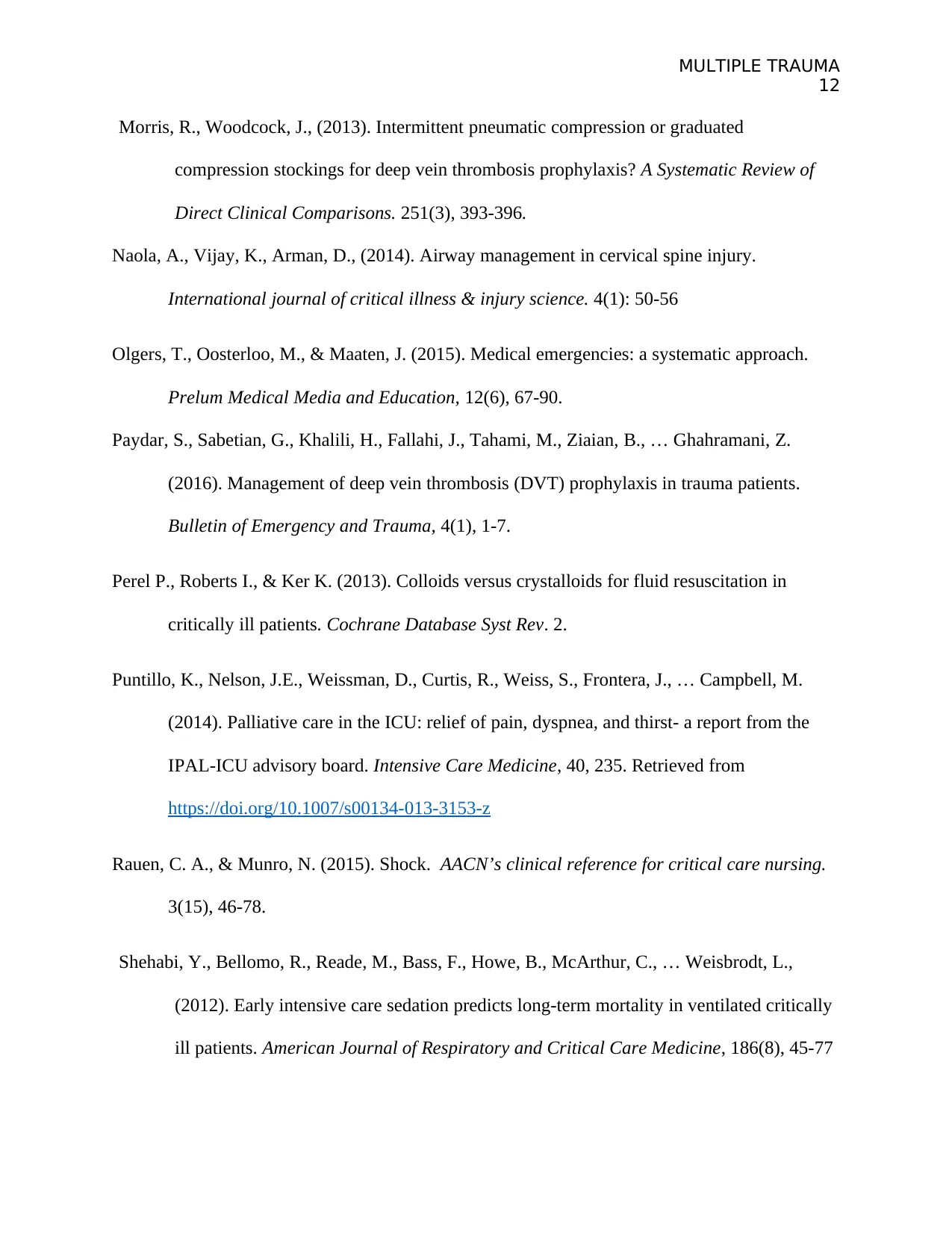
MULTIPLE TRAUMA
12
Morris, R., Woodcock, J., (2013). Intermittent pneumatic compression or graduated
compression stockings for deep vein thrombosis prophylaxis? A Systematic Review of
Direct Clinical Comparisons. 251(3), 393-396.
Naola, A., Vijay, K., Arman, D., (2014). Airway management in cervical spine injury.
International journal of critical illness & injury science. 4(1): 50-56
Olgers, T., Oosterloo, M., & Maaten, J. (2015). Medical emergencies: a systematic approach.
Prelum Medical Media and Education, 12(6), 67-90.
Paydar, S., Sabetian, G., Khalili, H., Fallahi, J., Tahami, M., Ziaian, B., … Ghahramani, Z.
(2016). Management of deep vein thrombosis (DVT) prophylaxis in trauma patients.
Bulletin of Emergency and Trauma, 4(1), 1-7.
Perel P., Roberts I., & Ker K. (2013). Colloids versus crystalloids for fluid resuscitation in
critically ill patients. Cochrane Database Syst Rev. 2.
Puntillo, K., Nelson, J.E., Weissman, D., Curtis, R., Weiss, S., Frontera, J., … Campbell, M.
(2014). Palliative care in the ICU: relief of pain, dyspnea, and thirst- a report from the
IPAL-ICU advisory board. Intensive Care Medicine, 40, 235. Retrieved from
https://doi.org/10.1007/s00134-013-3153-z
Rauen, C. A., & Munro, N. (2015). Shock. AACN’s clinical reference for critical care nursing.
3(15), 46-78.
Shehabi, Y., Bellomo, R., Reade, M., Bass, F., Howe, B., McArthur, C., … Weisbrodt, L.,
(2012). Early intensive care sedation predicts long-term mortality in ventilated critically
ill patients. American Journal of Respiratory and Critical Care Medicine, 186(8), 45-77
12
Morris, R., Woodcock, J., (2013). Intermittent pneumatic compression or graduated
compression stockings for deep vein thrombosis prophylaxis? A Systematic Review of
Direct Clinical Comparisons. 251(3), 393-396.
Naola, A., Vijay, K., Arman, D., (2014). Airway management in cervical spine injury.
International journal of critical illness & injury science. 4(1): 50-56
Olgers, T., Oosterloo, M., & Maaten, J. (2015). Medical emergencies: a systematic approach.
Prelum Medical Media and Education, 12(6), 67-90.
Paydar, S., Sabetian, G., Khalili, H., Fallahi, J., Tahami, M., Ziaian, B., … Ghahramani, Z.
(2016). Management of deep vein thrombosis (DVT) prophylaxis in trauma patients.
Bulletin of Emergency and Trauma, 4(1), 1-7.
Perel P., Roberts I., & Ker K. (2013). Colloids versus crystalloids for fluid resuscitation in
critically ill patients. Cochrane Database Syst Rev. 2.
Puntillo, K., Nelson, J.E., Weissman, D., Curtis, R., Weiss, S., Frontera, J., … Campbell, M.
(2014). Palliative care in the ICU: relief of pain, dyspnea, and thirst- a report from the
IPAL-ICU advisory board. Intensive Care Medicine, 40, 235. Retrieved from
https://doi.org/10.1007/s00134-013-3153-z
Rauen, C. A., & Munro, N. (2015). Shock. AACN’s clinical reference for critical care nursing.
3(15), 46-78.
Shehabi, Y., Bellomo, R., Reade, M., Bass, F., Howe, B., McArthur, C., … Weisbrodt, L.,
(2012). Early intensive care sedation predicts long-term mortality in ventilated critically
ill patients. American Journal of Respiratory and Critical Care Medicine, 186(8), 45-77
Paraphrase This Document
Need a fresh take? Get an instant paraphrase of this document with our AI Paraphraser
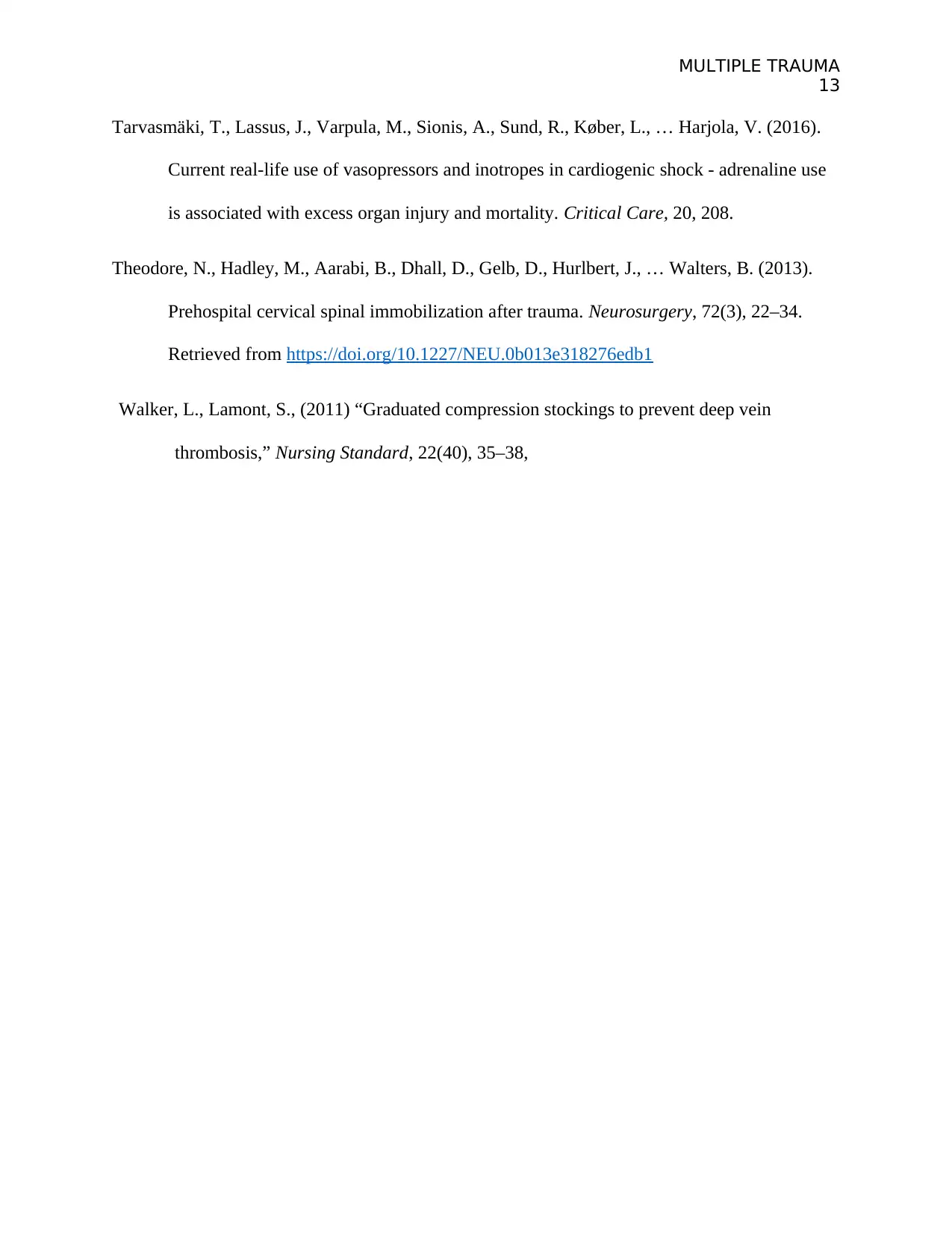
MULTIPLE TRAUMA
13
Tarvasmäki, T., Lassus, J., Varpula, M., Sionis, A., Sund, R., Køber, L., … Harjola, V. (2016).
Current real-life use of vasopressors and inotropes in cardiogenic shock - adrenaline use
is associated with excess organ injury and mortality. Critical Care, 20, 208.
Theodore, N., Hadley, M., Aarabi, B., Dhall, D., Gelb, D., Hurlbert, J., … Walters, B. (2013).
Prehospital cervical spinal immobilization after trauma. Neurosurgery, 72(3), 22–34.
Retrieved from https://doi.org/10.1227/NEU.0b013e318276edb1
Walker, L., Lamont, S., (2011) “Graduated compression stockings to prevent deep vein
thrombosis,” Nursing Standard, 22(40), 35–38,
13
Tarvasmäki, T., Lassus, J., Varpula, M., Sionis, A., Sund, R., Køber, L., … Harjola, V. (2016).
Current real-life use of vasopressors and inotropes in cardiogenic shock - adrenaline use
is associated with excess organ injury and mortality. Critical Care, 20, 208.
Theodore, N., Hadley, M., Aarabi, B., Dhall, D., Gelb, D., Hurlbert, J., … Walters, B. (2013).
Prehospital cervical spinal immobilization after trauma. Neurosurgery, 72(3), 22–34.
Retrieved from https://doi.org/10.1227/NEU.0b013e318276edb1
Walker, L., Lamont, S., (2011) “Graduated compression stockings to prevent deep vein
thrombosis,” Nursing Standard, 22(40), 35–38,
1 out of 14
Your All-in-One AI-Powered Toolkit for Academic Success.
+13062052269
info@desklib.com
Available 24*7 on WhatsApp / Email
![[object Object]](/_next/static/media/star-bottom.7253800d.svg)
Unlock your academic potential
© 2024 | Zucol Services PVT LTD | All rights reserved.

